MBA Project: Digital Transformation of TESCO - Business Analysis
VerifiedAdded on 2022/12/23
|24
|5311
|1
Project
AI Summary
This project analyzes the digital transformation of TESCO, a leading UK retail chain, focusing on enhancing its online and in-store operations. It addresses the company's need to adapt to changing consumer demands and the increasing use of mobile technology. The project outlines a digital transformation strategy, including an e-commerce business environment and the implementation of a "Click and Collect" service. It covers project objectives, scope, work breakdown structure (WBS), project charter, stakeholder analysis, project planning steps, cost estimation, risk management, and communication strategies. The project recommends strategies like market analysis (SWOT, PESTLE, Porter's Five Forces), high-security mechanisms, and training programs to improve skills. The goal is to increase market sustainability, improve business operations, and enhance customer experience by integrating offline and online contact points. The project aims to improve efficiency, customer reach, and order processing. The project is divided into phases, including initiation, planning, execution, control, monitoring, and closure, and also provides a WBS and project charter to ensure the project is carried out successfully.
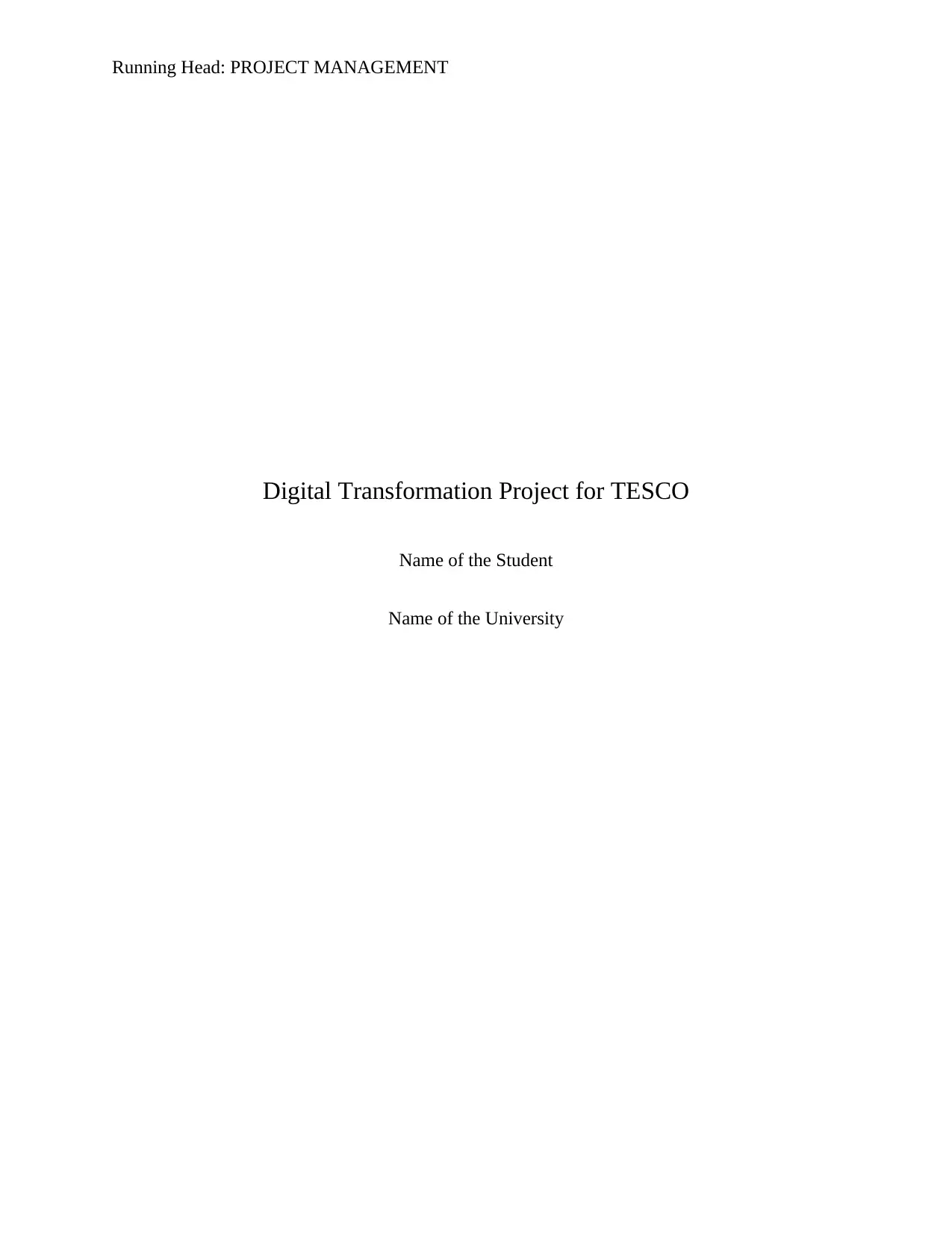
Running Head: PROJECT MANAGEMENT
Digital Transformation Project for TESCO
Name of the Student
Name of the University
Digital Transformation Project for TESCO
Name of the Student
Name of the University
Paraphrase This Document
Need a fresh take? Get an instant paraphrase of this document with our AI Paraphraser
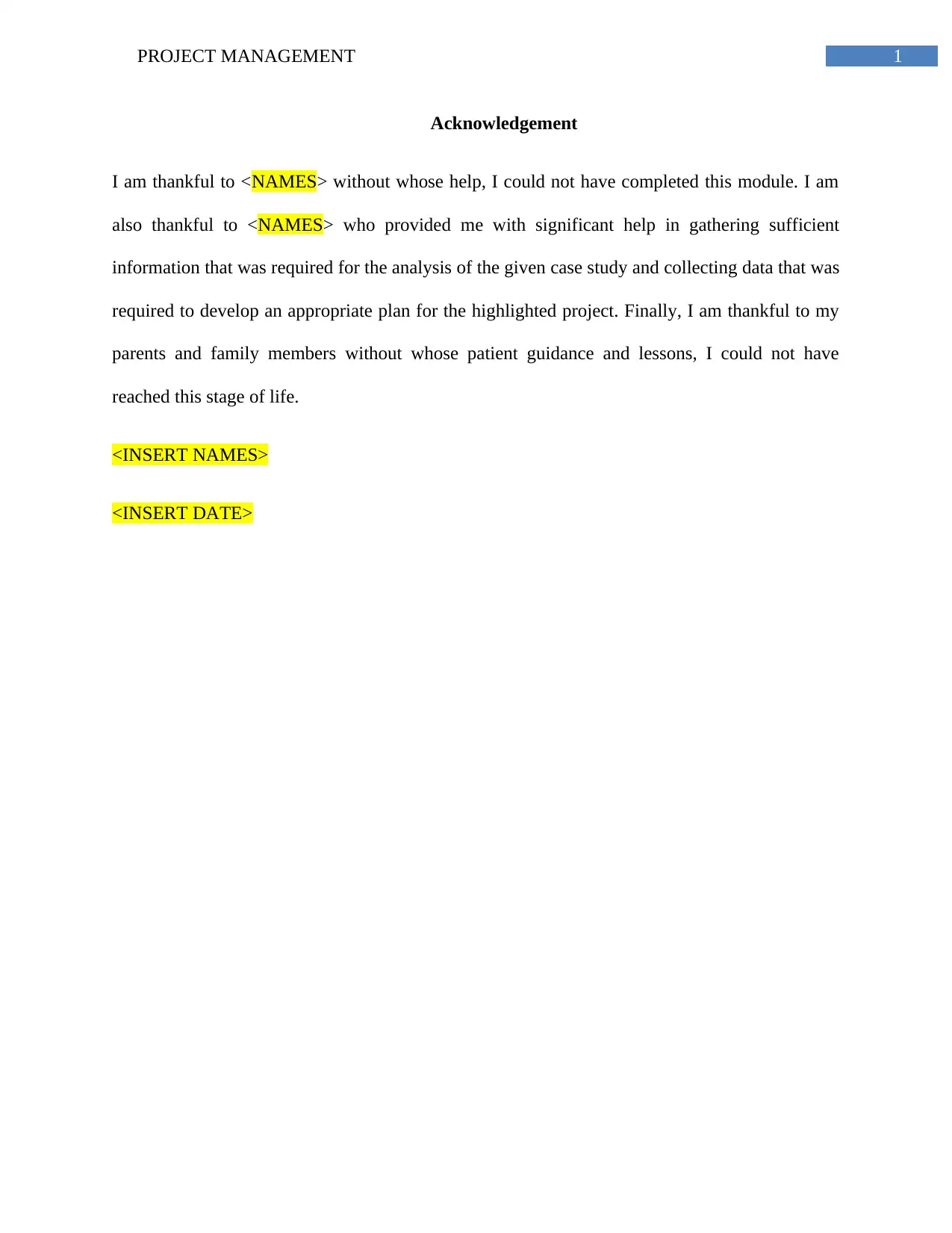
1PROJECT MANAGEMENT
Acknowledgement
I am thankful to <NAMES> without whose help, I could not have completed this module. I am
also thankful to <NAMES> who provided me with significant help in gathering sufficient
information that was required for the analysis of the given case study and collecting data that was
required to develop an appropriate plan for the highlighted project. Finally, I am thankful to my
parents and family members without whose patient guidance and lessons, I could not have
reached this stage of life.
<INSERT NAMES>
<INSERT DATE>
Acknowledgement
I am thankful to <NAMES> without whose help, I could not have completed this module. I am
also thankful to <NAMES> who provided me with significant help in gathering sufficient
information that was required for the analysis of the given case study and collecting data that was
required to develop an appropriate plan for the highlighted project. Finally, I am thankful to my
parents and family members without whose patient guidance and lessons, I could not have
reached this stage of life.
<INSERT NAMES>
<INSERT DATE>
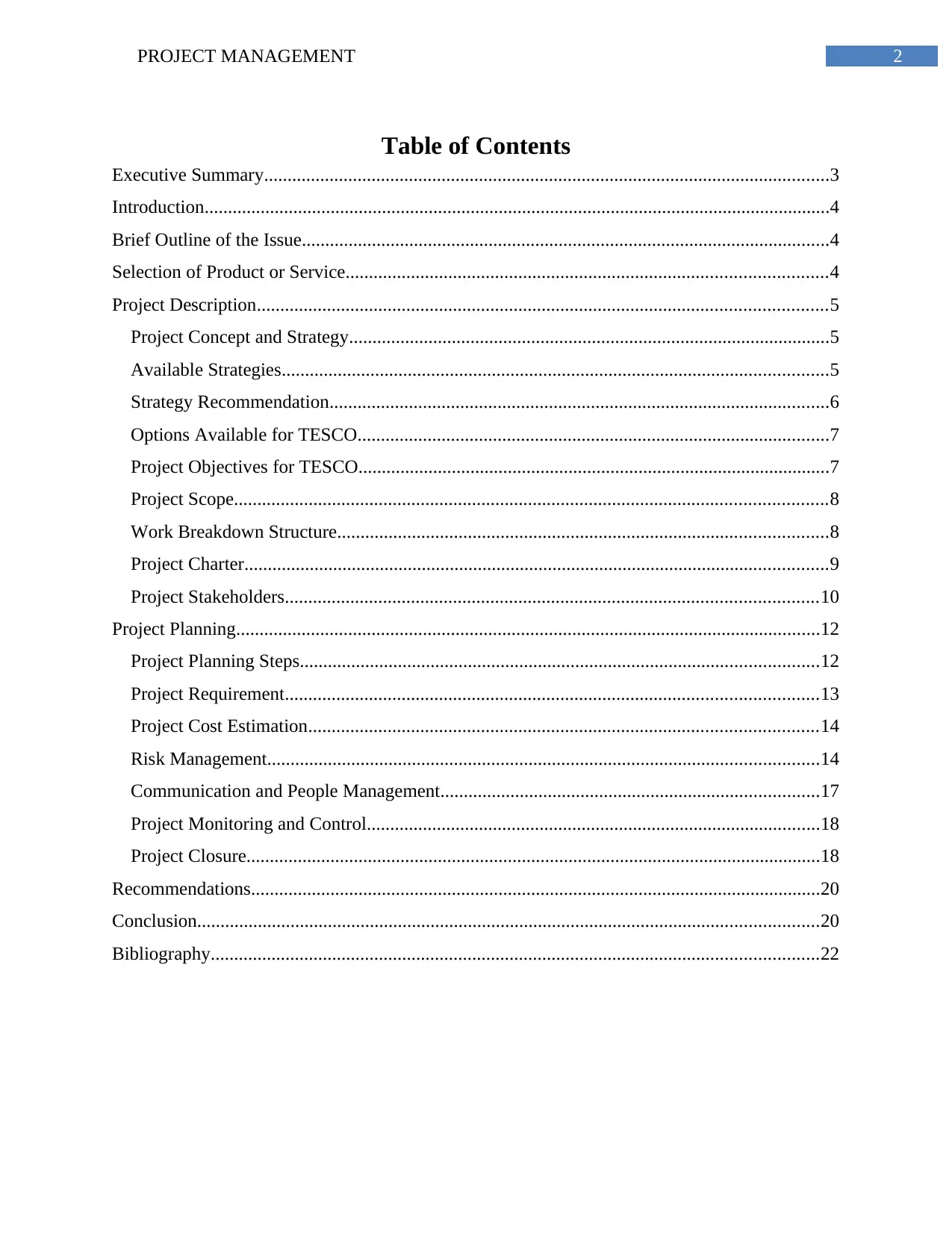
2PROJECT MANAGEMENT
Table of Contents
Executive Summary.........................................................................................................................3
Introduction......................................................................................................................................4
Brief Outline of the Issue.................................................................................................................4
Selection of Product or Service.......................................................................................................4
Project Description..........................................................................................................................5
Project Concept and Strategy.......................................................................................................5
Available Strategies.....................................................................................................................5
Strategy Recommendation...........................................................................................................6
Options Available for TESCO.....................................................................................................7
Project Objectives for TESCO.....................................................................................................7
Project Scope...............................................................................................................................8
Work Breakdown Structure.........................................................................................................8
Project Charter.............................................................................................................................9
Project Stakeholders..................................................................................................................10
Project Planning.............................................................................................................................12
Project Planning Steps...............................................................................................................12
Project Requirement..................................................................................................................13
Project Cost Estimation.............................................................................................................14
Risk Management......................................................................................................................14
Communication and People Management.................................................................................17
Project Monitoring and Control.................................................................................................18
Project Closure...........................................................................................................................18
Recommendations..........................................................................................................................20
Conclusion.....................................................................................................................................20
Bibliography..................................................................................................................................22
Table of Contents
Executive Summary.........................................................................................................................3
Introduction......................................................................................................................................4
Brief Outline of the Issue.................................................................................................................4
Selection of Product or Service.......................................................................................................4
Project Description..........................................................................................................................5
Project Concept and Strategy.......................................................................................................5
Available Strategies.....................................................................................................................5
Strategy Recommendation...........................................................................................................6
Options Available for TESCO.....................................................................................................7
Project Objectives for TESCO.....................................................................................................7
Project Scope...............................................................................................................................8
Work Breakdown Structure.........................................................................................................8
Project Charter.............................................................................................................................9
Project Stakeholders..................................................................................................................10
Project Planning.............................................................................................................................12
Project Planning Steps...............................................................................................................12
Project Requirement..................................................................................................................13
Project Cost Estimation.............................................................................................................14
Risk Management......................................................................................................................14
Communication and People Management.................................................................................17
Project Monitoring and Control.................................................................................................18
Project Closure...........................................................................................................................18
Recommendations..........................................................................................................................20
Conclusion.....................................................................................................................................20
Bibliography..................................................................................................................................22
⊘ This is a preview!⊘
Do you want full access?
Subscribe today to unlock all pages.

Trusted by 1+ million students worldwide
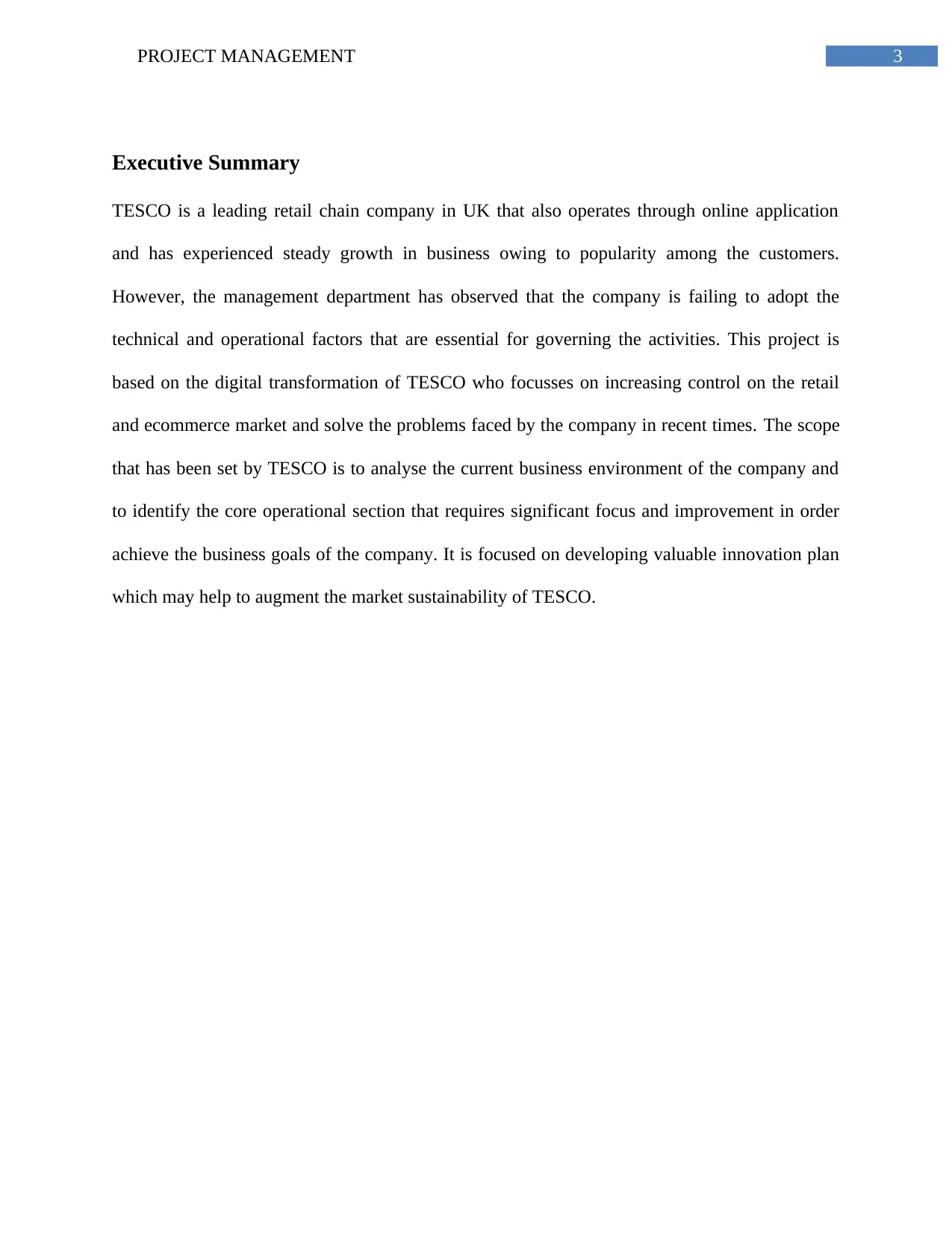
3PROJECT MANAGEMENT
Executive Summary
TESCO is a leading retail chain company in UK that also operates through online application
and has experienced steady growth in business owing to popularity among the customers.
However, the management department has observed that the company is failing to adopt the
technical and operational factors that are essential for governing the activities. This project is
based on the digital transformation of TESCO who focusses on increasing control on the retail
and ecommerce market and solve the problems faced by the company in recent times. The scope
that has been set by TESCO is to analyse the current business environment of the company and
to identify the core operational section that requires significant focus and improvement in order
achieve the business goals of the company. It is focused on developing valuable innovation plan
which may help to augment the market sustainability of TESCO.
Executive Summary
TESCO is a leading retail chain company in UK that also operates through online application
and has experienced steady growth in business owing to popularity among the customers.
However, the management department has observed that the company is failing to adopt the
technical and operational factors that are essential for governing the activities. This project is
based on the digital transformation of TESCO who focusses on increasing control on the retail
and ecommerce market and solve the problems faced by the company in recent times. The scope
that has been set by TESCO is to analyse the current business environment of the company and
to identify the core operational section that requires significant focus and improvement in order
achieve the business goals of the company. It is focused on developing valuable innovation plan
which may help to augment the market sustainability of TESCO.
Paraphrase This Document
Need a fresh take? Get an instant paraphrase of this document with our AI Paraphraser
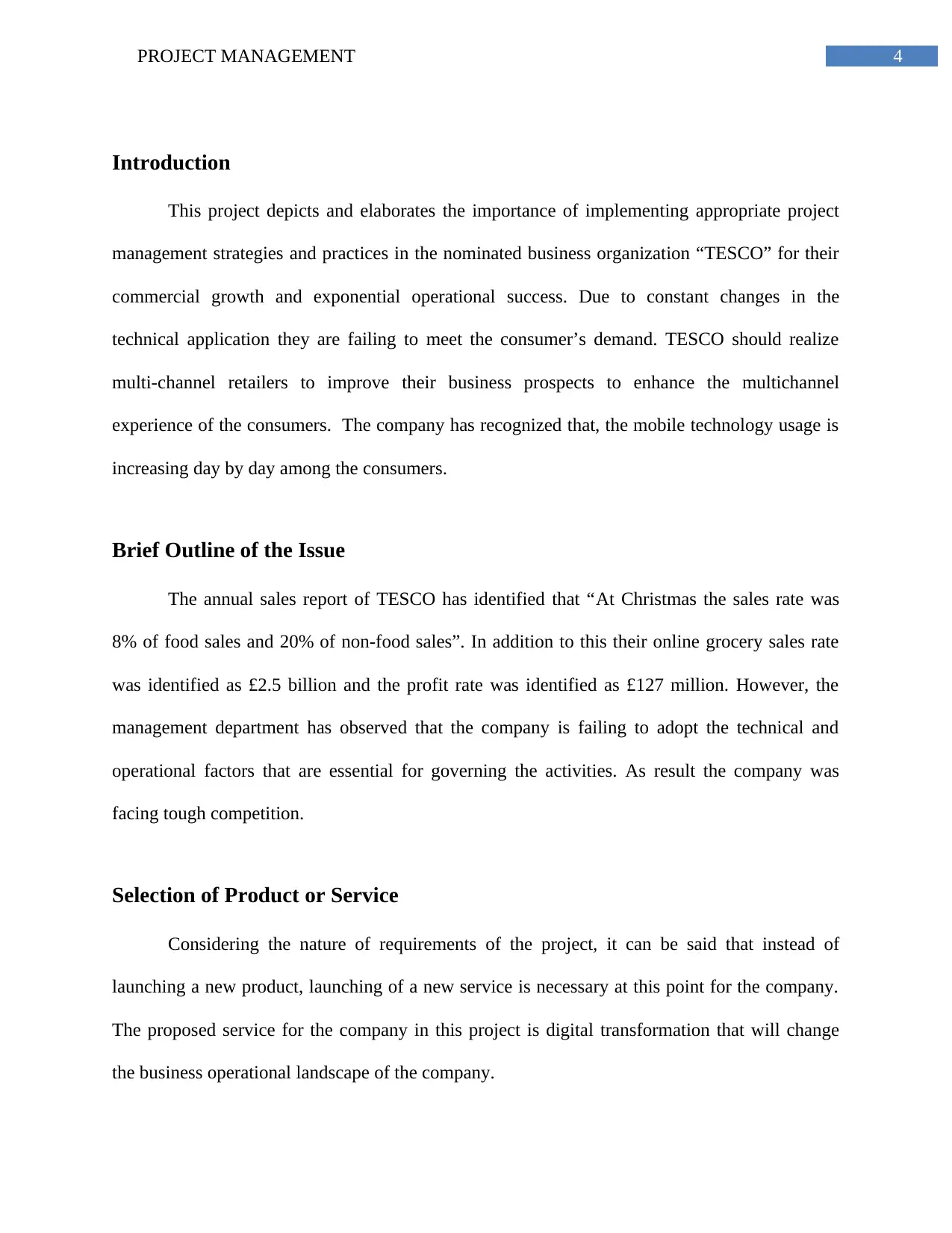
4PROJECT MANAGEMENT
Introduction
This project depicts and elaborates the importance of implementing appropriate project
management strategies and practices in the nominated business organization “TESCO” for their
commercial growth and exponential operational success. Due to constant changes in the
technical application they are failing to meet the consumer’s demand. TESCO should realize
multi-channel retailers to improve their business prospects to enhance the multichannel
experience of the consumers. The company has recognized that, the mobile technology usage is
increasing day by day among the consumers.
Brief Outline of the Issue
The annual sales report of TESCO has identified that “At Christmas the sales rate was
8% of food sales and 20% of non-food sales”. In addition to this their online grocery sales rate
was identified as £2.5 billion and the profit rate was identified as £127 million. However, the
management department has observed that the company is failing to adopt the technical and
operational factors that are essential for governing the activities. As result the company was
facing tough competition.
Selection of Product or Service
Considering the nature of requirements of the project, it can be said that instead of
launching a new product, launching of a new service is necessary at this point for the company.
The proposed service for the company in this project is digital transformation that will change
the business operational landscape of the company.
Introduction
This project depicts and elaborates the importance of implementing appropriate project
management strategies and practices in the nominated business organization “TESCO” for their
commercial growth and exponential operational success. Due to constant changes in the
technical application they are failing to meet the consumer’s demand. TESCO should realize
multi-channel retailers to improve their business prospects to enhance the multichannel
experience of the consumers. The company has recognized that, the mobile technology usage is
increasing day by day among the consumers.
Brief Outline of the Issue
The annual sales report of TESCO has identified that “At Christmas the sales rate was
8% of food sales and 20% of non-food sales”. In addition to this their online grocery sales rate
was identified as £2.5 billion and the profit rate was identified as £127 million. However, the
management department has observed that the company is failing to adopt the technical and
operational factors that are essential for governing the activities. As result the company was
facing tough competition.
Selection of Product or Service
Considering the nature of requirements of the project, it can be said that instead of
launching a new product, launching of a new service is necessary at this point for the company.
The proposed service for the company in this project is digital transformation that will change
the business operational landscape of the company.
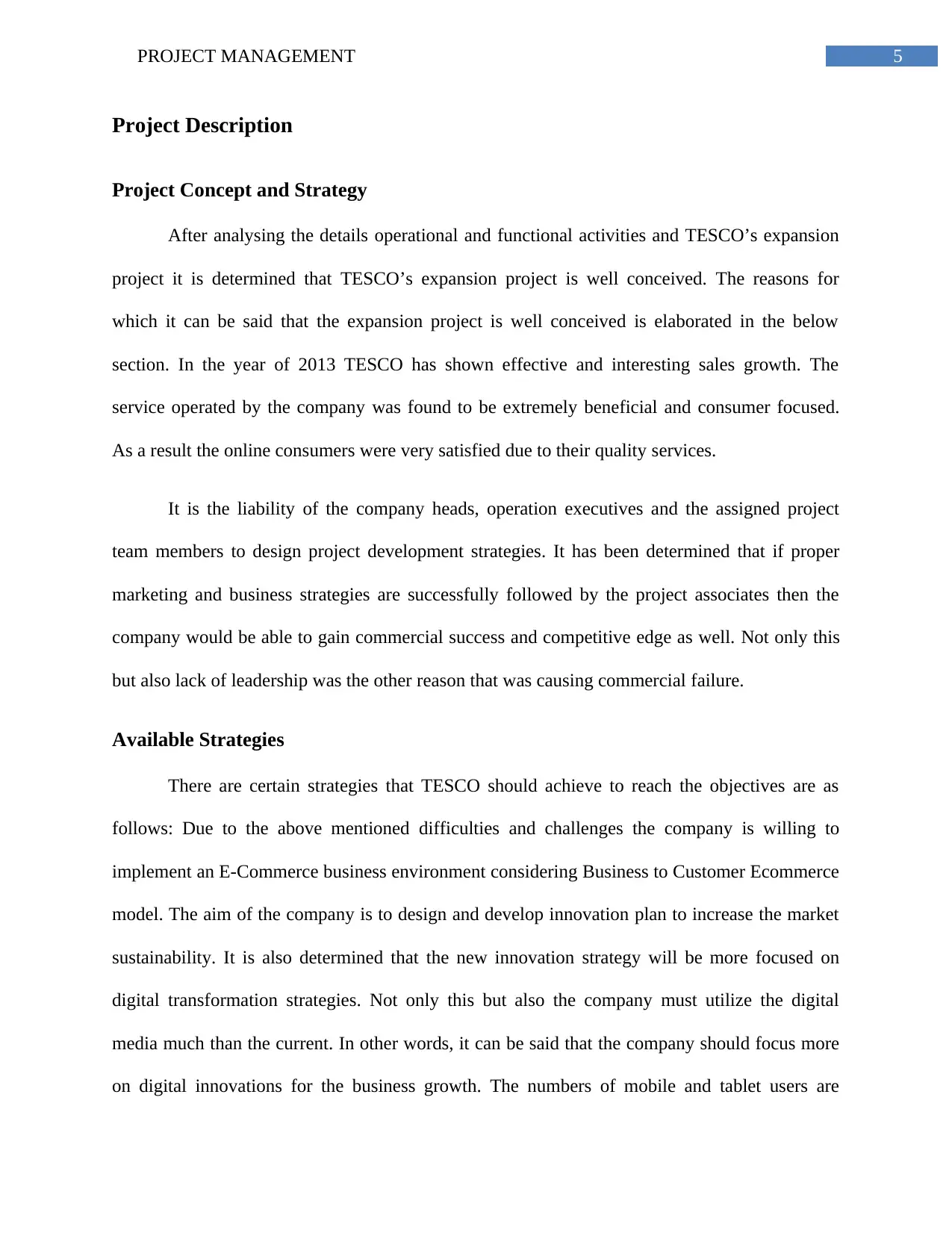
5PROJECT MANAGEMENT
Project Description
Project Concept and Strategy
After analysing the details operational and functional activities and TESCO’s expansion
project it is determined that TESCO’s expansion project is well conceived. The reasons for
which it can be said that the expansion project is well conceived is elaborated in the below
section. In the year of 2013 TESCO has shown effective and interesting sales growth. The
service operated by the company was found to be extremely beneficial and consumer focused.
As a result the online consumers were very satisfied due to their quality services.
It is the liability of the company heads, operation executives and the assigned project
team members to design project development strategies. It has been determined that if proper
marketing and business strategies are successfully followed by the project associates then the
company would be able to gain commercial success and competitive edge as well. Not only this
but also lack of leadership was the other reason that was causing commercial failure.
Available Strategies
There are certain strategies that TESCO should achieve to reach the objectives are as
follows: Due to the above mentioned difficulties and challenges the company is willing to
implement an E-Commerce business environment considering Business to Customer Ecommerce
model. The aim of the company is to design and develop innovation plan to increase the market
sustainability. It is also determined that the new innovation strategy will be more focused on
digital transformation strategies. Not only this but also the company must utilize the digital
media much than the current. In other words, it can be said that the company should focus more
on digital innovations for the business growth. The numbers of mobile and tablet users are
Project Description
Project Concept and Strategy
After analysing the details operational and functional activities and TESCO’s expansion
project it is determined that TESCO’s expansion project is well conceived. The reasons for
which it can be said that the expansion project is well conceived is elaborated in the below
section. In the year of 2013 TESCO has shown effective and interesting sales growth. The
service operated by the company was found to be extremely beneficial and consumer focused.
As a result the online consumers were very satisfied due to their quality services.
It is the liability of the company heads, operation executives and the assigned project
team members to design project development strategies. It has been determined that if proper
marketing and business strategies are successfully followed by the project associates then the
company would be able to gain commercial success and competitive edge as well. Not only this
but also lack of leadership was the other reason that was causing commercial failure.
Available Strategies
There are certain strategies that TESCO should achieve to reach the objectives are as
follows: Due to the above mentioned difficulties and challenges the company is willing to
implement an E-Commerce business environment considering Business to Customer Ecommerce
model. The aim of the company is to design and develop innovation plan to increase the market
sustainability. It is also determined that the new innovation strategy will be more focused on
digital transformation strategies. Not only this but also the company must utilize the digital
media much than the current. In other words, it can be said that the company should focus more
on digital innovations for the business growth. The numbers of mobile and tablet users are
⊘ This is a preview!⊘
Do you want full access?
Subscribe today to unlock all pages.

Trusted by 1+ million students worldwide
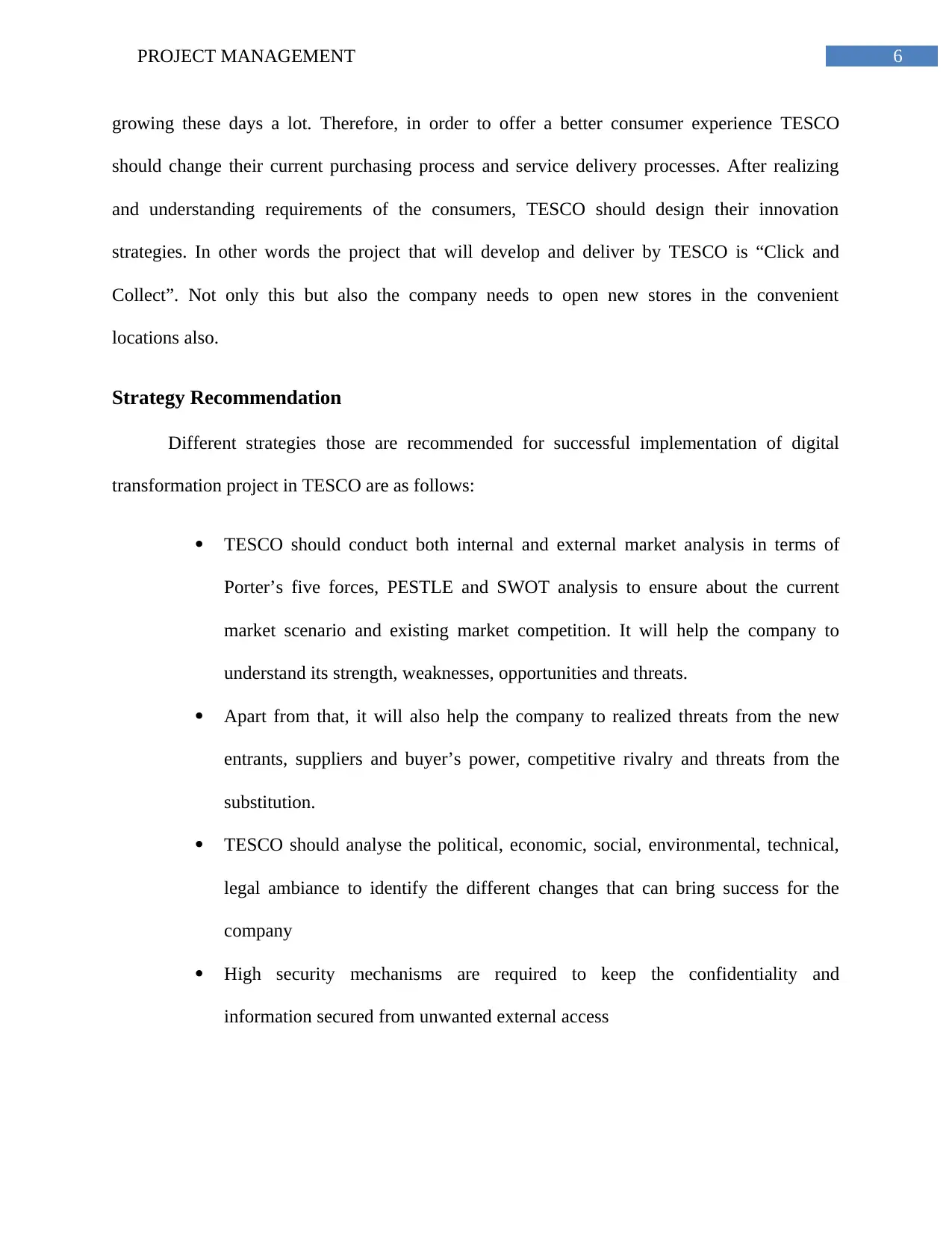
6PROJECT MANAGEMENT
growing these days a lot. Therefore, in order to offer a better consumer experience TESCO
should change their current purchasing process and service delivery processes. After realizing
and understanding requirements of the consumers, TESCO should design their innovation
strategies. In other words the project that will develop and deliver by TESCO is “Click and
Collect”. Not only this but also the company needs to open new stores in the convenient
locations also.
Strategy Recommendation
Different strategies those are recommended for successful implementation of digital
transformation project in TESCO are as follows:
TESCO should conduct both internal and external market analysis in terms of
Porter’s five forces, PESTLE and SWOT analysis to ensure about the current
market scenario and existing market competition. It will help the company to
understand its strength, weaknesses, opportunities and threats.
Apart from that, it will also help the company to realized threats from the new
entrants, suppliers and buyer’s power, competitive rivalry and threats from the
substitution.
TESCO should analyse the political, economic, social, environmental, technical,
legal ambiance to identify the different changes that can bring success for the
company
High security mechanisms are required to keep the confidentiality and
information secured from unwanted external access
growing these days a lot. Therefore, in order to offer a better consumer experience TESCO
should change their current purchasing process and service delivery processes. After realizing
and understanding requirements of the consumers, TESCO should design their innovation
strategies. In other words the project that will develop and deliver by TESCO is “Click and
Collect”. Not only this but also the company needs to open new stores in the convenient
locations also.
Strategy Recommendation
Different strategies those are recommended for successful implementation of digital
transformation project in TESCO are as follows:
TESCO should conduct both internal and external market analysis in terms of
Porter’s five forces, PESTLE and SWOT analysis to ensure about the current
market scenario and existing market competition. It will help the company to
understand its strength, weaknesses, opportunities and threats.
Apart from that, it will also help the company to realized threats from the new
entrants, suppliers and buyer’s power, competitive rivalry and threats from the
substitution.
TESCO should analyse the political, economic, social, environmental, technical,
legal ambiance to identify the different changes that can bring success for the
company
High security mechanisms are required to keep the confidentiality and
information secured from unwanted external access
Paraphrase This Document
Need a fresh take? Get an instant paraphrase of this document with our AI Paraphraser
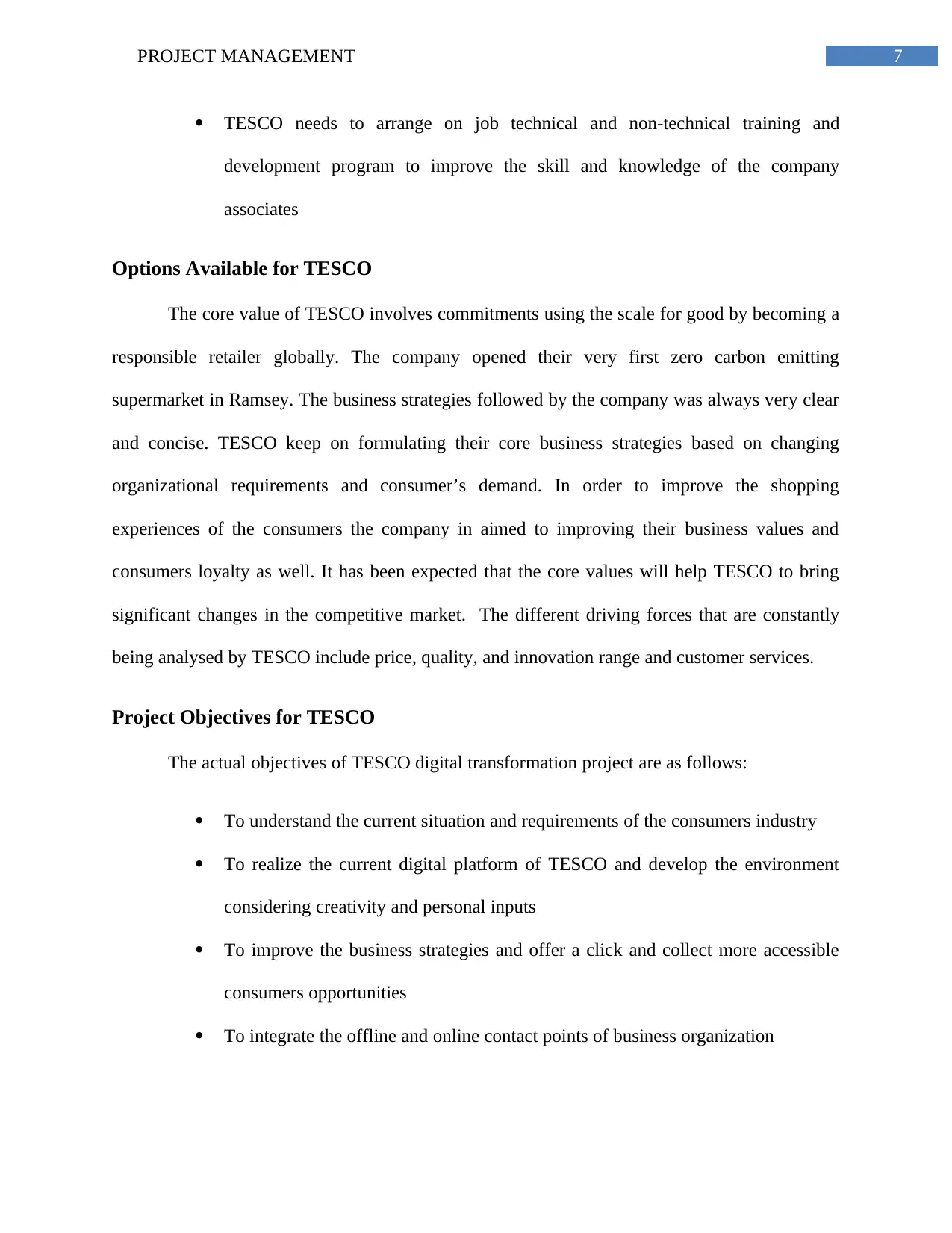
7PROJECT MANAGEMENT
TESCO needs to arrange on job technical and non-technical training and
development program to improve the skill and knowledge of the company
associates
Options Available for TESCO
The core value of TESCO involves commitments using the scale for good by becoming a
responsible retailer globally. The company opened their very first zero carbon emitting
supermarket in Ramsey. The business strategies followed by the company was always very clear
and concise. TESCO keep on formulating their core business strategies based on changing
organizational requirements and consumer’s demand. In order to improve the shopping
experiences of the consumers the company in aimed to improving their business values and
consumers loyalty as well. It has been expected that the core values will help TESCO to bring
significant changes in the competitive market. The different driving forces that are constantly
being analysed by TESCO include price, quality, and innovation range and customer services.
Project Objectives for TESCO
The actual objectives of TESCO digital transformation project are as follows:
To understand the current situation and requirements of the consumers industry
To realize the current digital platform of TESCO and develop the environment
considering creativity and personal inputs
To improve the business strategies and offer a click and collect more accessible
consumers opportunities
To integrate the offline and online contact points of business organization
TESCO needs to arrange on job technical and non-technical training and
development program to improve the skill and knowledge of the company
associates
Options Available for TESCO
The core value of TESCO involves commitments using the scale for good by becoming a
responsible retailer globally. The company opened their very first zero carbon emitting
supermarket in Ramsey. The business strategies followed by the company was always very clear
and concise. TESCO keep on formulating their core business strategies based on changing
organizational requirements and consumer’s demand. In order to improve the shopping
experiences of the consumers the company in aimed to improving their business values and
consumers loyalty as well. It has been expected that the core values will help TESCO to bring
significant changes in the competitive market. The different driving forces that are constantly
being analysed by TESCO include price, quality, and innovation range and customer services.
Project Objectives for TESCO
The actual objectives of TESCO digital transformation project are as follows:
To understand the current situation and requirements of the consumers industry
To realize the current digital platform of TESCO and develop the environment
considering creativity and personal inputs
To improve the business strategies and offer a click and collect more accessible
consumers opportunities
To integrate the offline and online contact points of business organization
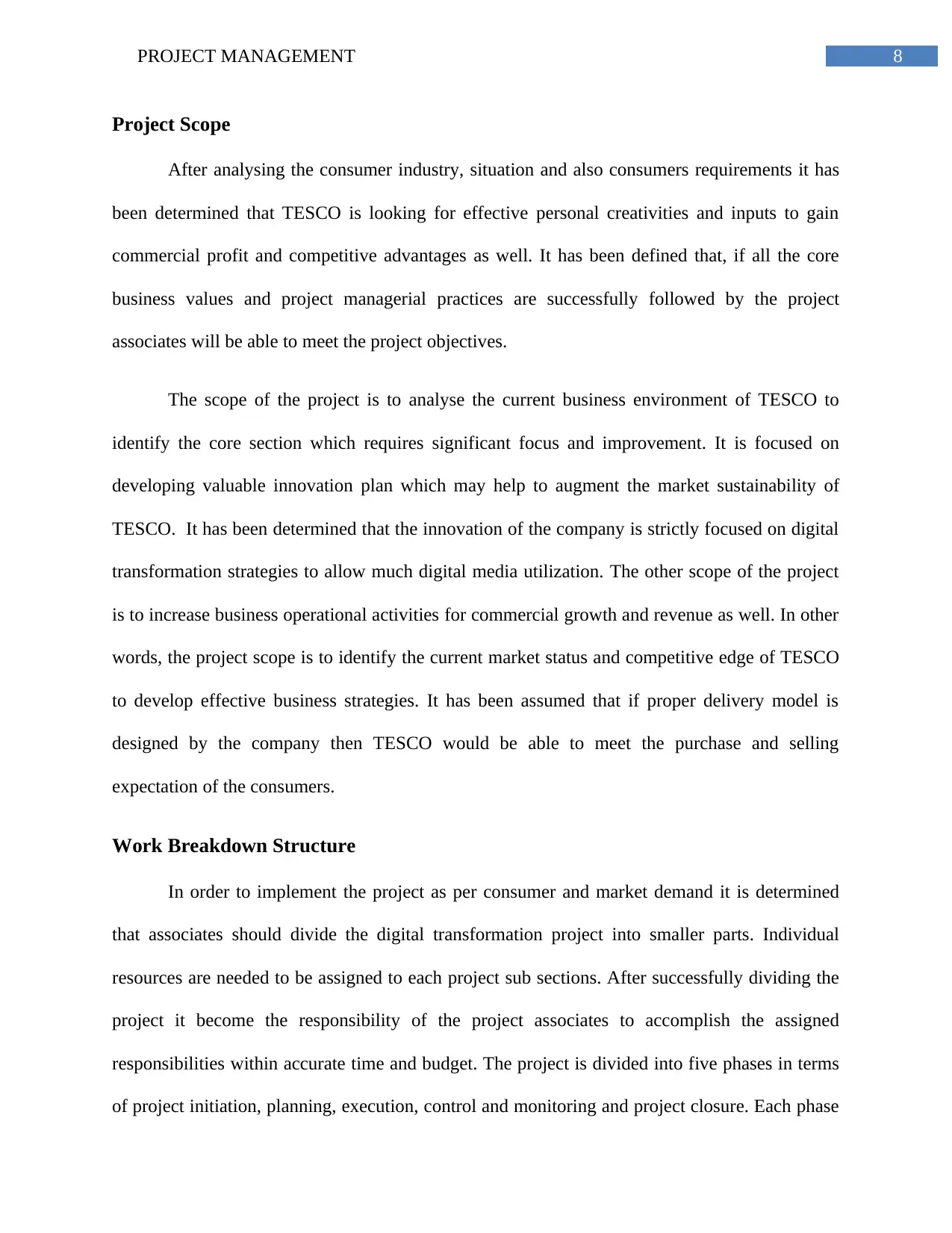
8PROJECT MANAGEMENT
Project Scope
After analysing the consumer industry, situation and also consumers requirements it has
been determined that TESCO is looking for effective personal creativities and inputs to gain
commercial profit and competitive advantages as well. It has been defined that, if all the core
business values and project managerial practices are successfully followed by the project
associates will be able to meet the project objectives.
The scope of the project is to analyse the current business environment of TESCO to
identify the core section which requires significant focus and improvement. It is focused on
developing valuable innovation plan which may help to augment the market sustainability of
TESCO. It has been determined that the innovation of the company is strictly focused on digital
transformation strategies to allow much digital media utilization. The other scope of the project
is to increase business operational activities for commercial growth and revenue as well. In other
words, the project scope is to identify the current market status and competitive edge of TESCO
to develop effective business strategies. It has been assumed that if proper delivery model is
designed by the company then TESCO would be able to meet the purchase and selling
expectation of the consumers.
Work Breakdown Structure
In order to implement the project as per consumer and market demand it is determined
that associates should divide the digital transformation project into smaller parts. Individual
resources are needed to be assigned to each project sub sections. After successfully dividing the
project it become the responsibility of the project associates to accomplish the assigned
responsibilities within accurate time and budget. The project is divided into five phases in terms
of project initiation, planning, execution, control and monitoring and project closure. Each phase
Project Scope
After analysing the consumer industry, situation and also consumers requirements it has
been determined that TESCO is looking for effective personal creativities and inputs to gain
commercial profit and competitive advantages as well. It has been defined that, if all the core
business values and project managerial practices are successfully followed by the project
associates will be able to meet the project objectives.
The scope of the project is to analyse the current business environment of TESCO to
identify the core section which requires significant focus and improvement. It is focused on
developing valuable innovation plan which may help to augment the market sustainability of
TESCO. It has been determined that the innovation of the company is strictly focused on digital
transformation strategies to allow much digital media utilization. The other scope of the project
is to increase business operational activities for commercial growth and revenue as well. In other
words, the project scope is to identify the current market status and competitive edge of TESCO
to develop effective business strategies. It has been assumed that if proper delivery model is
designed by the company then TESCO would be able to meet the purchase and selling
expectation of the consumers.
Work Breakdown Structure
In order to implement the project as per consumer and market demand it is determined
that associates should divide the digital transformation project into smaller parts. Individual
resources are needed to be assigned to each project sub sections. After successfully dividing the
project it become the responsibility of the project associates to accomplish the assigned
responsibilities within accurate time and budget. The project is divided into five phases in terms
of project initiation, planning, execution, control and monitoring and project closure. Each phase
⊘ This is a preview!⊘
Do you want full access?
Subscribe today to unlock all pages.

Trusted by 1+ million students worldwide
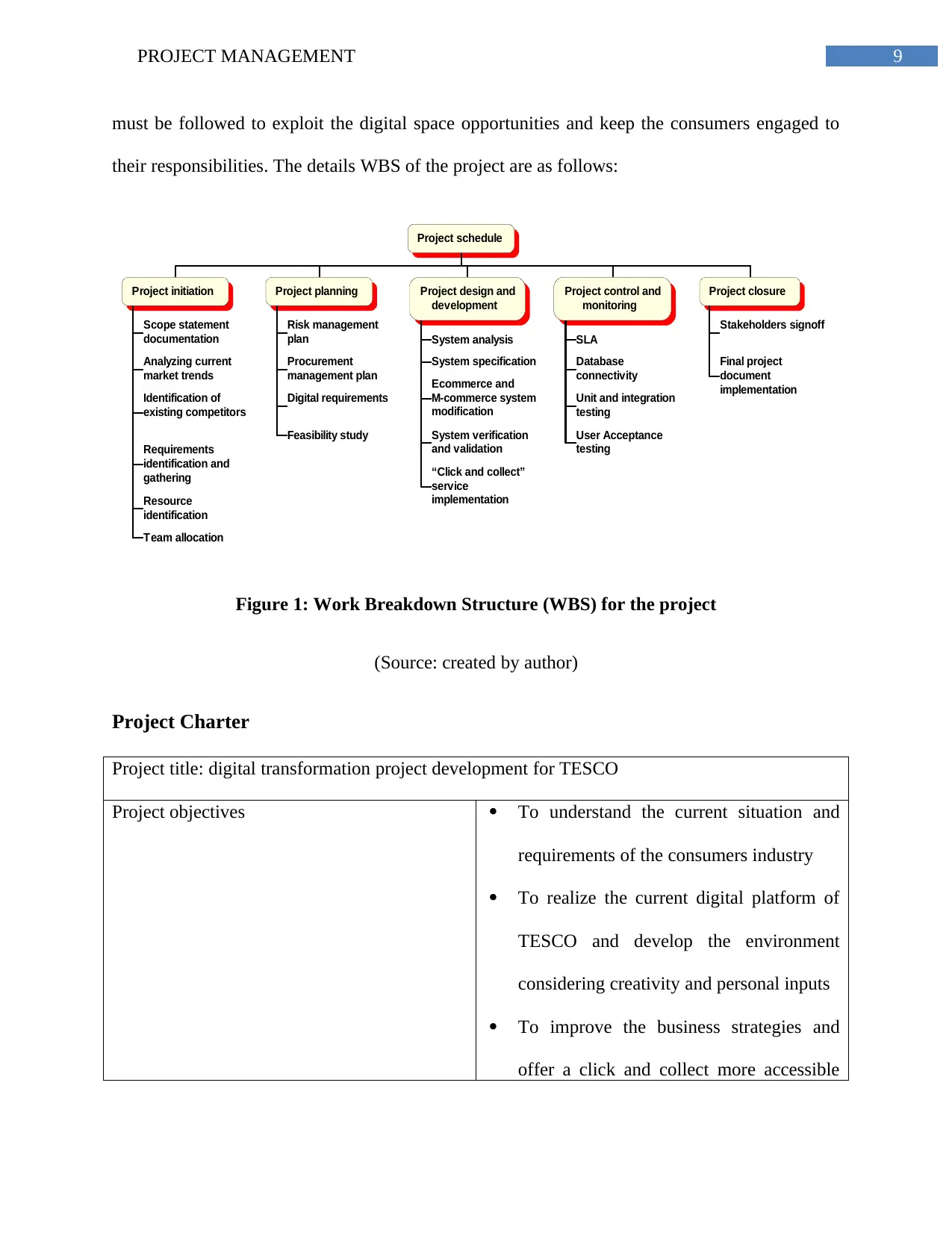
9PROJECT MANAGEMENT
must be followed to exploit the digital space opportunities and keep the consumers engaged to
their responsibilities. The details WBS of the project are as follows:
Project schedule
Project initiation
Scope statement
documentation
Analyzing current
market trends
Identification of
existing competitors
Requirements
identification and
gathering
Resource
identification
Team allocation
Project planning
Risk management
plan
Procurement
management plan
Digital requirements
Feasibility study
Project design and
development
System analysis
System specification
Ecommerce and
M-commerce system
modification
System verification
and validation
“Click and collect”
service
implementation
Project control and
monitoring
SLA
Database
connectivity
Unit and integration
testing
User Acceptance
testing
Project closure
Stakeholders signoff
Final project
document
implementation
Figure 1: Work Breakdown Structure (WBS) for the project
(Source: created by author)
Project Charter
Project title: digital transformation project development for TESCO
Project objectives To understand the current situation and
requirements of the consumers industry
To realize the current digital platform of
TESCO and develop the environment
considering creativity and personal inputs
To improve the business strategies and
offer a click and collect more accessible
must be followed to exploit the digital space opportunities and keep the consumers engaged to
their responsibilities. The details WBS of the project are as follows:
Project schedule
Project initiation
Scope statement
documentation
Analyzing current
market trends
Identification of
existing competitors
Requirements
identification and
gathering
Resource
identification
Team allocation
Project planning
Risk management
plan
Procurement
management plan
Digital requirements
Feasibility study
Project design and
development
System analysis
System specification
Ecommerce and
M-commerce system
modification
System verification
and validation
“Click and collect”
service
implementation
Project control and
monitoring
SLA
Database
connectivity
Unit and integration
testing
User Acceptance
testing
Project closure
Stakeholders signoff
Final project
document
implementation
Figure 1: Work Breakdown Structure (WBS) for the project
(Source: created by author)
Project Charter
Project title: digital transformation project development for TESCO
Project objectives To understand the current situation and
requirements of the consumers industry
To realize the current digital platform of
TESCO and develop the environment
considering creativity and personal inputs
To improve the business strategies and
offer a click and collect more accessible
Paraphrase This Document
Need a fresh take? Get an instant paraphrase of this document with our AI Paraphraser
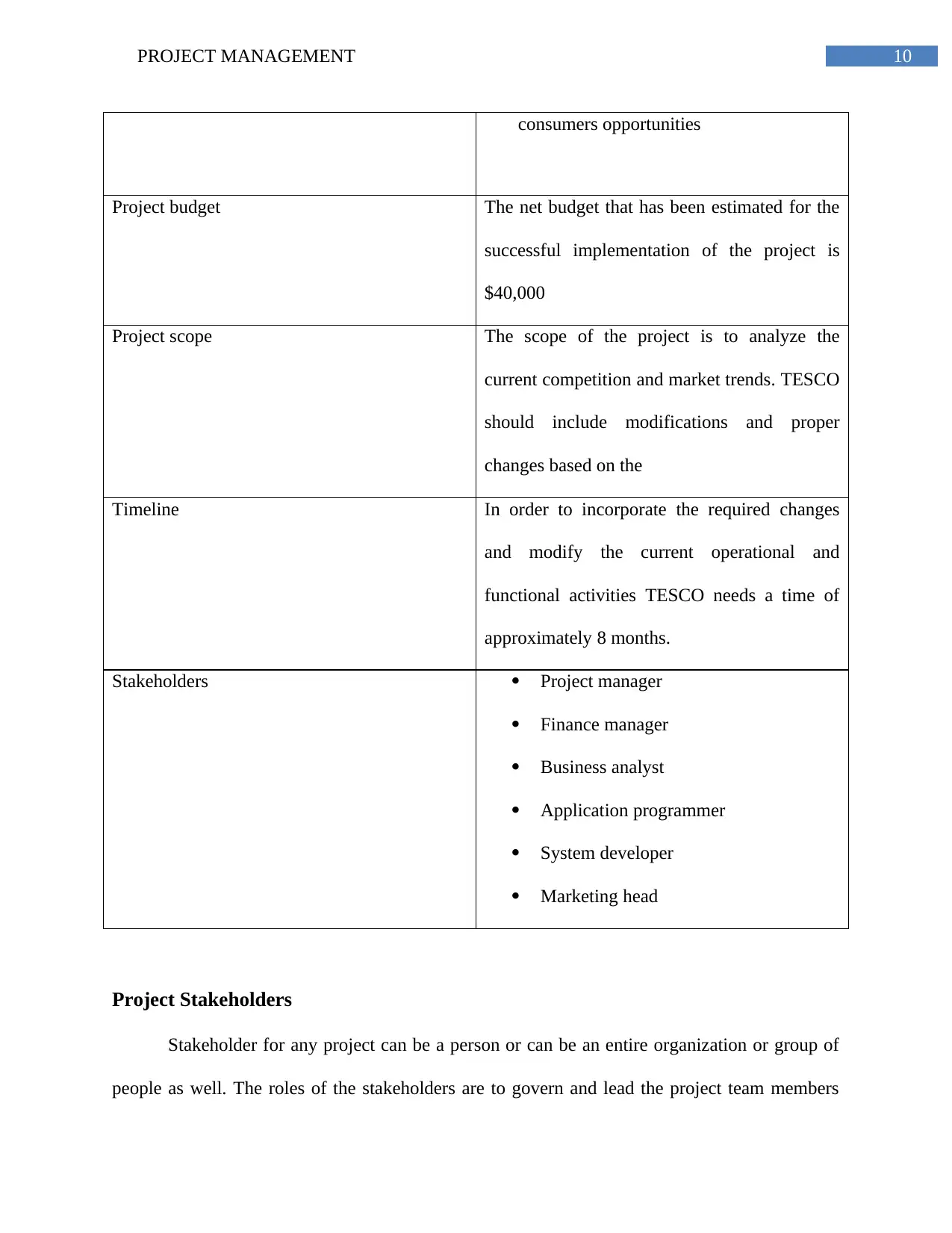
10PROJECT MANAGEMENT
consumers opportunities
Project budget The net budget that has been estimated for the
successful implementation of the project is
$40,000
Project scope The scope of the project is to analyze the
current competition and market trends. TESCO
should include modifications and proper
changes based on the
Timeline In order to incorporate the required changes
and modify the current operational and
functional activities TESCO needs a time of
approximately 8 months.
Stakeholders Project manager
Finance manager
Business analyst
Application programmer
System developer
Marketing head
Project Stakeholders
Stakeholder for any project can be a person or can be an entire organization or group of
people as well. The roles of the stakeholders are to govern and lead the project team members
consumers opportunities
Project budget The net budget that has been estimated for the
successful implementation of the project is
$40,000
Project scope The scope of the project is to analyze the
current competition and market trends. TESCO
should include modifications and proper
changes based on the
Timeline In order to incorporate the required changes
and modify the current operational and
functional activities TESCO needs a time of
approximately 8 months.
Stakeholders Project manager
Finance manager
Business analyst
Application programmer
System developer
Marketing head
Project Stakeholders
Stakeholder for any project can be a person or can be an entire organization or group of
people as well. The roles of the stakeholders are to govern and lead the project team members
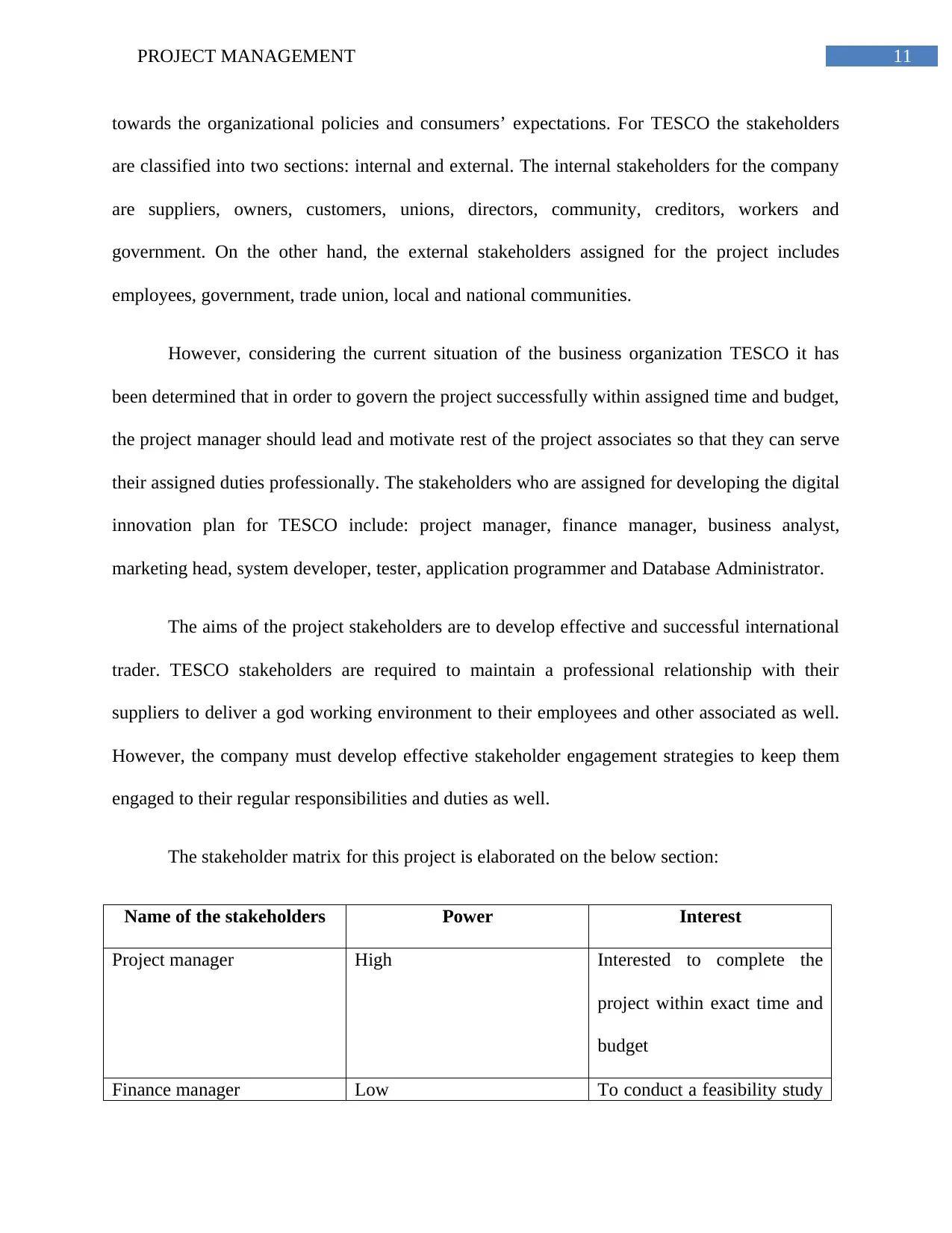
11PROJECT MANAGEMENT
towards the organizational policies and consumers’ expectations. For TESCO the stakeholders
are classified into two sections: internal and external. The internal stakeholders for the company
are suppliers, owners, customers, unions, directors, community, creditors, workers and
government. On the other hand, the external stakeholders assigned for the project includes
employees, government, trade union, local and national communities.
However, considering the current situation of the business organization TESCO it has
been determined that in order to govern the project successfully within assigned time and budget,
the project manager should lead and motivate rest of the project associates so that they can serve
their assigned duties professionally. The stakeholders who are assigned for developing the digital
innovation plan for TESCO include: project manager, finance manager, business analyst,
marketing head, system developer, tester, application programmer and Database Administrator.
The aims of the project stakeholders are to develop effective and successful international
trader. TESCO stakeholders are required to maintain a professional relationship with their
suppliers to deliver a god working environment to their employees and other associated as well.
However, the company must develop effective stakeholder engagement strategies to keep them
engaged to their regular responsibilities and duties as well.
The stakeholder matrix for this project is elaborated on the below section:
Name of the stakeholders Power Interest
Project manager High Interested to complete the
project within exact time and
budget
Finance manager Low To conduct a feasibility study
towards the organizational policies and consumers’ expectations. For TESCO the stakeholders
are classified into two sections: internal and external. The internal stakeholders for the company
are suppliers, owners, customers, unions, directors, community, creditors, workers and
government. On the other hand, the external stakeholders assigned for the project includes
employees, government, trade union, local and national communities.
However, considering the current situation of the business organization TESCO it has
been determined that in order to govern the project successfully within assigned time and budget,
the project manager should lead and motivate rest of the project associates so that they can serve
their assigned duties professionally. The stakeholders who are assigned for developing the digital
innovation plan for TESCO include: project manager, finance manager, business analyst,
marketing head, system developer, tester, application programmer and Database Administrator.
The aims of the project stakeholders are to develop effective and successful international
trader. TESCO stakeholders are required to maintain a professional relationship with their
suppliers to deliver a god working environment to their employees and other associated as well.
However, the company must develop effective stakeholder engagement strategies to keep them
engaged to their regular responsibilities and duties as well.
The stakeholder matrix for this project is elaborated on the below section:
Name of the stakeholders Power Interest
Project manager High Interested to complete the
project within exact time and
budget
Finance manager Low To conduct a feasibility study
⊘ This is a preview!⊘
Do you want full access?
Subscribe today to unlock all pages.

Trusted by 1+ million students worldwide
1 out of 24
Related Documents
Your All-in-One AI-Powered Toolkit for Academic Success.
+13062052269
info@desklib.com
Available 24*7 on WhatsApp / Email
![[object Object]](/_next/static/media/star-bottom.7253800d.svg)
Unlock your academic potential
Copyright © 2020–2025 A2Z Services. All Rights Reserved. Developed and managed by ZUCOL.





